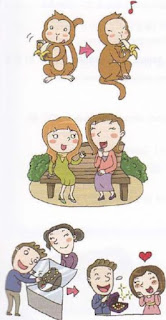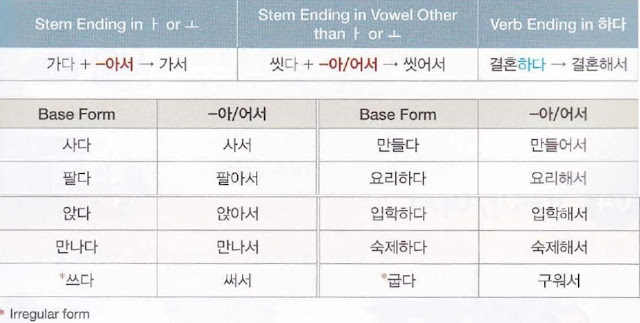 바나나를 까서 먹었어요.
바나나를 까서 먹었어요.
(The monkey) peeled a banana and ate it.
네 시간동안 공원에 앉아서 이야기했어요.
(We) sat in a park for four hours and talked.
여자 친구에게 목걸이를 사(서) 주었어요.
I bought a necklace for my girlfriend and gave it to her.
Grammar Focus:
-아/어서 is a connective ending indicating the temporal relationship between events. Specifically, it expresses the occurrence of the action in the second clause after the action in the first clause has occurred. The two actions are so closely related that the second action cannot occur without the first action occurring first. This expression corresponds to ‘and’ or ‘(in order) to’ in English.
Moreover, 서 can often be omitted from -아/어서, leaving just -아/어 but this is not possible with certain verbs, including 가다 (to go), 오다 (to come), and 서다 (to stand). It is formed by adding -아서 to stems ending in the vowel ㅏ or ㅗ. Otherwise, -어서 is added. For verbs ending in 하다, 해서 is added.

In the case of sentences in the past, present, or future tense, the tense is expressed only in the second verb, not the first.
• 어제 친구를 만나서 영회를 봤어요.
Yesterday, I met a friend to watch a movie.
• 내일 친구를 만나서 영화를 볼 거예요.
Tomorrow, I will meet a friend to watch a movie.
The subjects of both verbs are the same.
• 나는 어제 친구를 만나서 (나는) 영화를 봤어요. (〇)
Yesterday I met a friend and (I) watched a movie.
나는 어제 친구를 만나서 친구는 영화를 봤어요. (X)
Conversation:
A: 왜 사과를 깎지 않고 먹어요?
Why do you eat apples without peeling them?
B: 사과를 깎아서 먹으면 맛이 없어요.
Apples aren’t tasty if you peel and eat them.
A: 오늘 학교에 지하철로 왔어요?
Did you come to school by subway today?
B: 네, 그런데 한 시간 동안 서서 와서 다리가 아파요.
Yes, but on the way, I stood for an hour, and (so) my legs are sore.
A: 왜 아르바이트를 해요? Why are you doing that part-time job?
B: 돈을 벌어서 카메라를 살 거예요.
(I plan) to make some money and buy a camera.
Comparison:
1. -고 is a connective ending similar to -아/어서 in that it indicates the temporal relationship between events. However, while -아/어서 is used when the first and second actions are very closely related, -고 is used to connect two unrelated actions that happen sequentially.
• 과일을 씻어서 (그 과일을) 먹어요.
(l/You) wash the fruit and eat It (the fruit).
• 과일을 씻고 (다른 음식을) 먹어요.
(l/You) wash the fruit and then eat (something else).
• 친구를 만나서 (그 친구와 같이) 영화를 봤어요.
I met a friend and (together we) watched a movie.
• 친구를 만나고 (나 혼자 또는 다른 사람과) 영화를 봤어요.
I met a friend and then (I by myself or with somebody else) watched a movie.
2. When used with verbs designating the wearing of clothes and accessories, -고 is used in place of -아/어서.
• 코트를 입어서 공부해요. (X)
->코트를 입고 공부해요. (〇)
I put on a coat and study.
• 사람들이 우산을 써서 가요. (X)
->사람들이 우산을 쓰고 가요 (〇)
People are putting up their umbrellas and going.
• 아이가 안경을 써서 책을 봐요. (X)
->아이가 안경을 쓰고 책을 봐요. (〇)
The child puts on glasses to read books.
>> Full of ‘Korean grammar in use – Beginner’: Click here
>> Fanpage: Say Hi Korean
